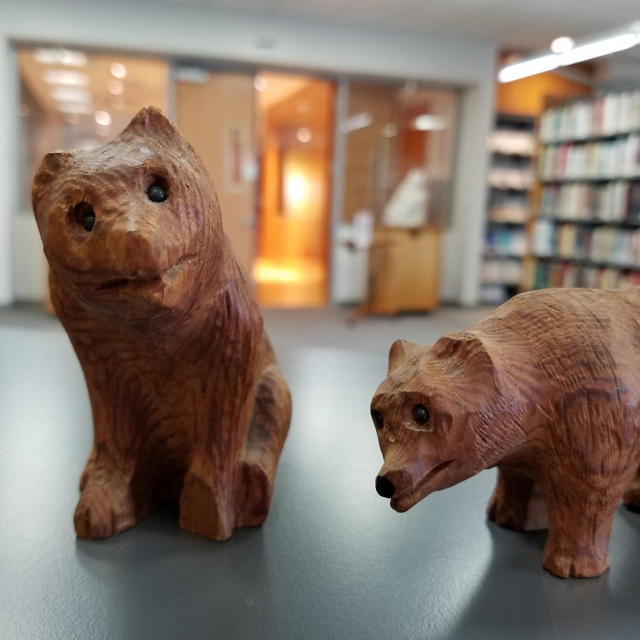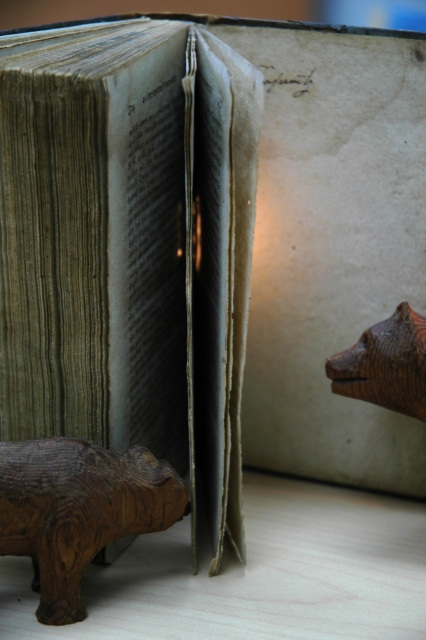
Meet the California Room Bears - Al & Sam Ursus!
This clawsome pair of bears was found hibernating among the archival collections of the California Room of the Dr. Martin Luther King, Jr. Library!
It may be winter, but they do not mind one bit. They have been found sustaining themselves on the plethora of knowledge that is within paws reach in our collection such as the Historic Photograph Collection, the various Maps and Aerial Photographs of the area, old photographs of San José from the Redevelopment Agency, and the Townsend Family Papers.
Albert E. (top image, left) and Samantha C. (top image, right) Ursus have PAWsitive and curious natures. Their adventures in our collections will be documented on the San José Public Library’s Instagram account (@sanjoselibrary). Check out their first post on Instagram and keep an eye out for their future adventures!
Maybe you will be the one to crack some of their mysteries…
...like the mystery of the holes in this book!
To celebrate Sam and Al, here is the BEAR truth on California bears:
- The last wild California Grizzly (Ursus arctos) was a male who went by the name of Monarch. He was kept in captivity in Golden Gate Park for twenty years and was euthanized in 1911.
- Although grizzly bears no longer roam California, it has a lasting legacy on our state flag and the Great Seal of California. It is also our official state animal.
- The only wild bear species still found in California are black bears (Ursus americanus). Their habitat consists mainly of forested regions.
- Black bear coats come in more shades than just black – they can also be brown or cinnamon colored. Some even have white patches on their throat or belly! On the other hand, a grizzly bear's coat may be any shade between blond to black, not just brown. Since coats are not a good way to tell the two bears apart, their physical build distinguishes them. A large shoulder hump distinguishes a grizzly bear, while black bears have taller ears and a straight profile of the face.
- Grizzly bears and black bears are omnivores. This means that, like us, they eat both plant and animals. A black bear’s diet consist of berries, nuts, truffles (underground fungi), and various other vegetation. Despite their large size they do not typically hunt large prey such as deer. Instead, their animal diet consists largely of ant and beetle larvae. They will also consume mice, ground squirrels and birds. When they do consume large prey, such as deer, it has likely been dead for quite some time meaning that bears are eating carrion. They also eat human food, which can become a serious problem for people AND bears.
- Black bears and grizzly bears have been found alongside mega fauna of the Pleistocene epoch (10,000 to 40,000 years ago) at the La Brea tar pits of Los Angeles. The tar pits also revealed that another bear lived in the area during the same time period: the short-faced bear (Arctodus spp.). The short-faced bear was about one foot taller than a grizzly bear when on all four and their diet likely consisted of more meat than the diets of black and grizzly bears. Surprisingly, the closest living relative of the short-faced bear is the speckled bear of South America, not grizzlies or black bears. (Who would have guessed?)
- At one point the grizzly bear’s taxonomic (Latin biological classification) name was Ursus horribilis which translates to “horrible bear.” This was a reflection of people’s sentiments towards grizzlies at the time. The current taxonomic name of grizzly bears, Ursus arctos, roughly translates to "northern bear".
- Two bear constellations are present in the sky of the northern hemisphere (where San José is located). They are known as Ursus Major (Big bear) and Ursus Minor (Small/little bear). Another common name for these constellations is the Big Dipper and Little Dipper, respectively. The Northern Star marks the tip of the tail of Ursus Major.
Want to learn more about bears in California? Perhaps you are curious about the history of San José and California. Either way, come to the California Room at the Dr. Martin Luther King, Jr. Library and browse through our books on grizzlies and California fauna.
- Track of the Grizzly by Frank C. Craighead, Jr.
- Bear in Mind: The California Grizzly edited with an introduction and commentary by Susan Snyder
- Mammals of California by E. W. Jameson, Jr., and Hans J. Peeters
written by Marisol Roman




Add a comment to: Bear Advice – California Room